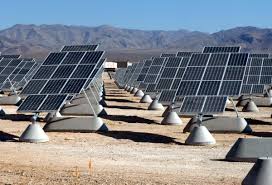Power Evacuation Solution
 Power evacuation is a critical function that allows generated power to be immediately evacuated from the WPP to the grid for distribution. PV&G with its team of highly experienced professionals cater to this requirement, thus ensuring the energy from the Wind farm is evacuated into the Grid.
Power evacuation is a critical function that allows generated power to be immediately evacuated from the WPP to the grid for distribution. PV&G with its team of highly experienced professionals cater to this requirement, thus ensuring the energy from the Wind farm is evacuated into the Grid.
PV&G conducts overall Power System Studies in the area where wind power potential exists. PV&G has the expertise and a deep understanding of the grid network and have proven track record in constructing new substations at voltage levels ranging from 110 KV to 220 KV. Construction of substation also includes engineering of the Sub-Station. The State of the art Sub-Stations are fully functional across many states in India.
Power utilities planning or investing in the electric power system face new challenges due to the ever-changing nature of the industry and the increasing pressure on network reliability. Among these important related issues are:
- Maximizing the capacity of aging transmission infrastructure
- Managing incr. amounts of intermittent, renewable generation
- Deployment of Smart Grid technologies
By increasing the complexity of transmission investment decisions, these and other factors demand fundamental changes in the way transmission planning is done. PV&G is recognized as one of India's leading consulting and technology solutions providers to the Power Sector, with expertise in the areas of transmission planning & operations.
Utilizing state-of-the-art technology, PV&G helps its clients maximize the reliability of their electric power facilities in the most economical manner. Tangible schemes for improved management of transmission networks and optimized strategies for future financial investments are prepared using world renowned & acclaimed tools like CYME from CYME International T&D, Canada or PTW from SKM System Analysis, Inc., USA. Multiple scenarios are evaluated along with the client while conducting:
- Investment feasibility and economic analysis
- Congestion analysis
- Renewable integration ( Power Evacuation Studies)
- System optimization studies ( Optimal Power Flows & AC Contingency Studies)
- High-level transmission planning strategy development
- Static power flow and dynamic system studies
- System black start studies and studies for Transient & Voltage stabilities
- Reliability and power quality studies
Besides, PV&G provide solutions for GPS Survey, line profiling and detailed design of Transmission lines using world reputed software tools like PLS-CADD. PV&G use PLS-CADD for plan and profile with optimum spotting and automatic selection of towers. However, manual survey and spotting of tower with templates is carried out, if required by the client. PV&G has capability of designing steel towers (Transmission or Telecom) using TOWER software.
Location survey
 Solar PV installers should conduct detailed site assessments before carrying out any installation work. They should study the project drawings and co-ordinate their work with that of other trades to ensure that no obstacles will be placed in the way of the Solar PV installation
Solar PV installers should conduct detailed site assessments before carrying out any installation work. They should study the project drawings and co-ordinate their work with that of other trades to ensure that no obstacles will be placed in the way of the Solar PV installation If the Solar PV array is to be mounted at ground level or on and existing flat roof then the opportunities to achieve an optimum orientation and optimum angle of tilt are much more likely. In the case of a proposed installation on the roof of a new building, there will be a certain amount of design flexibility. It is likely that the first principles of locating the Solar PV array will initially be decided on rule of thumb basis. It is later that more accurate date can be collected to optimise the energy collected at any particular location.
Solar PV panels can be fitted on, or integral with, pitched roofs. Alternatively they can be fitted on to the flat roof of a building using using angled mountings. Another possibility is to mount the Solar PV panels on a wall. This can work well with longer, slimmer panels that can be mounted at an angle without protruding too far from the wall itself. Any of these options can work well as long as no part of the panel is shaded from the sun. In addition to roofs, solar equipment may also be mounted on racks sitting on the ground or on the roofs of sheds, carports, or other outbuildings. All of the same rules apply for site evaluation.
